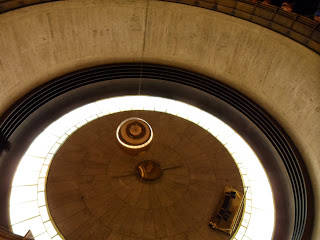Joyce's inspiration came from her quick encountering with a bird. A bird hit her window one day and fell to the ground as if it was dead. She went outside and touched the bird to check on it. However, after a while the bird stood up and simply flew away. By then, she had realize that the bird was in shock and once it recovered its sense, it flew away. That encountering led her into doing research on the bird, the place where the pain struck the bird and sent the bird into shock. She also explored the ancestry of birds, and went to Munich where the fossil of the "first bird"(half bird- half dinosaur) was discovered on limestone.
Her early research of birds led to her interest in pigeons. This photo of a pigeon is part of the slideshow on display.
After weeks of watching her podcast and learning the relationships between art and science, I was finally able to meet Professor Vesna in person. We took a photo in front of the artworks on exhibition. The art works are from the artist's earlier project The New York Odyssey. The project consists of images from her personal history and places she has been to when she lived in New York.
This picture conveyed how fish and human are similar at the embryo stage, in which their gills are our limbs. Other pictures of the embryo of a human are also trying to convey the same idea. The center image is a face scan of her brain. The top row consists of photos of painting from the museum of natural history of Amsterdam. The photo of a man bending over and a man standing up straight is our typical evolution cycle. She added into this set of project because it relates how we have came to be and supports the idea that fish and human have similar attributes.

Figure 5
I had the pleasure to speaking to Joyce and really learned about how her experience had inspired her to produce her works. For example, the New York Project is a project of photos she took of the city she grew up in. The bird incident led her into research in the anatomy of the bird and what the bird went through while it was in shock. In addition, she also had a picture of dissection in Figure 5, middle of the top row, from the history museum of Amsterdam in the collage of 12 photos.











































